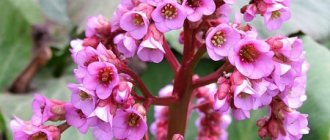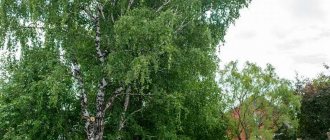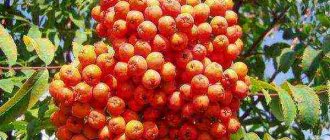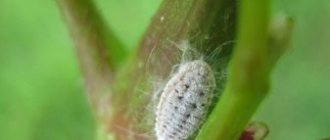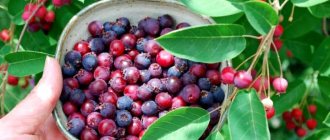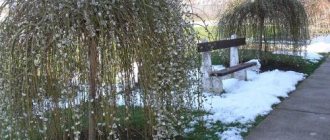Decorative rowan planting and care. Growing rowan in the garden
Primary requirements
Rowan is light-loving, although it tolerates light shading, it is moisture-loving, but does not tolerate excess water, is sensitive to air pollution and serves as an indicator of its purity.
The root system of rowan is superficial, the bulk of the roots lie at a depth of up to 50 cm. However, the groundwater level should be no closer than 2 m from the soil surface. Rowan grows best on light and medium loams. On sandy soils, once every 2 years it is necessary to add manure or compost to dig up the tree trunk, and on heavy clay soils, add sand. Every spring or autumn, plants should be mulched with peat or compost.
Pears are often grafted onto rowan trees, but not all pear varieties are compatible with such grafting. Aronia, chaenomeles and other plants of the Rosaceae family are also grafted onto rowan. If there is already a rowan tree with bitter fruits growing on the site and the tree is no older than 15 years, it can be regrafted into the crown with cuttings of sweet varieties. Vaccinations are done in the spring.
Planting rowan
Rowan can be planted in spring and autumn. The planting pattern is 3 x 4 m. For autumn planting, holes must be dug in 2-3 weeks, and for spring planting - in the fall. The size of the pit is 100 x 60 cm. 20 kg of compost with the addition of topsoil and 30 g of double superphosphate and potassium sulfate are added to it. After planting, you should water the seedling abundantly, compact the soil and mulch the tree trunk circle.
Trimming
Rowan appears in all its glory if it grows freely, but in the garden, where it is often crowded, pruning is necessary. This should be done in early spring before the buds swell. While the trees are young, it is enough to shorten the shoots to the outer bud and remove excess branches. When the tree reaches full fruiting, once every 2-3 years in the spring you can shorten the skeletal branches to 2-5-year-old wood, as well as systematically shorten and thin out the ringlets. Old, poorly growing trees are rejuvenated by heavy pruning.
Reproduction
Species rowan trees are propagated by seeds, including for growing rootstock seedlings onto which varieties are grafted. Seeds must be stratified for at least three months in damp sand at a temperature of 1-5 °C. Rowan varieties are propagated only vegetatively: by grafting, layering, and green cuttings.
HARVEST. Rowan seedlings begin to bear fruit in the 5-6th year after planting, grafted plants - in the 2-3rd year. The productive age of trees is usually no more than 20 years. With good care, the yield is 40-80 kg per tree. Timely harvested fruits are stored well in cool rooms for 4-5 months.
Diseases and pests
It is believed that rowan is resistant to pests and diseases, but it has many enemies. The most dangerous damage to rowan is bacterial burn. Symptoms: flowers turn black, shoot tips wither and bend, gum oozes from the bark. The affected plant will have to be destroyed.
Leaves can be affected by powdery mildew, brown spot, scab, rust (if there are rowan and juniper nearby).
Fruits can be severely affected by fruit rot. Trunks are mainly affected by necrosis of various natures. Tinder fungi can settle on old trees.
Of the pests, rowan is affected by aphids, rowan moth, hawthorn, cherry slimy sawfly, red apple mite, flower beetles and bark beetles.
Since diseases and pests spread to rowan from other fruit crops, it is treated with pesticides along with them. Young, strong plants are usually mildly affected.
Planting rowan
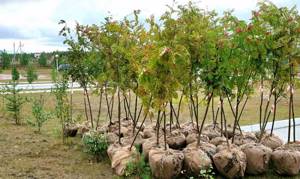
Since the rowan tree grows quite tall, it is wise to plant it at the border of the garden so that it does not shade your area. Rowan prefers fertile soils (medium and light loams that retain moisture well), however, it grows normally in poorer soils. Rowan is planted, like other fruit trees, in the spring, before the sap begins to flow, or in the fall, during the leaf fall period. If you expect to harvest berries, then plant several varieties at once.
When choosing rowan seedlings, pay special attention to the condition of their root system: it should be well-developed and healthy, that is, have 2-3 main branches more than 20 cm long. If the roots of the plant are weathered and dry, then it is better not to buy such planting material. The bark of the seedling must be smooth and not wrinkled. Tear off a small piece of bark and look at the inside: it should be green, not brown like a dead plant. Prepare seedlings for planting by removing diseased, dried and broken roots and shoots. Before autumn planting, leaves are also removed from the branches of the seedling, being careful not to damage the buds in their axils.
Rowan seedlings are placed on the site at intervals of 4 to 6 m from each other and from other trees. The depth and diameter of the hole should be from 60 to 80 cm. Prepare a mixture of 5 kg of peat compost and topsoil, add 2 to 3 shovels of rotted manure, 200 g of superphosphate and 100 g of wood ash to it and mix everything well. Fill the holes one-third full with this mixture, then fill the pit halfway with regular soil, pour a bucket of water into it and let it soak.
Dip the roots of the seedling into the clay mash, place it in the center of the hole and fill the space with the remaining potting mix or topsoil. After planting, thoroughly compact the surface around the seedling and water it with water. The seedling must be 2-3 cm deeper in the ground than it grew in the nursery. When the water is absorbed, mulch the tree trunk circle with a layer of humus, hay, grass, straw, peat, sawdust or other organic material 5 to 10 cm thick.
Types of rowan. Popular types and varieties of rowan
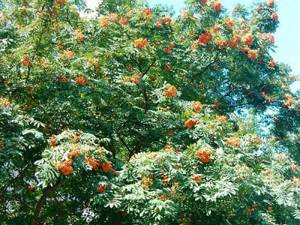
The rowan bush or tree belongs to the Rosaceae family. There are about a hundred of its species in the world. Rowan grows in North America, Europe and Asia.
Ruby rowan
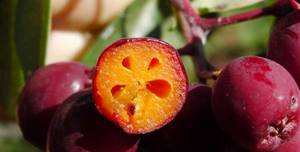
Medium height plant. The length reaches from 3 to 4 m. The average weight of the fruit of such rowan is 1 – 1.5 g. The berries have a flattened shape and yellow flesh. They taste sweet and sour. The leaves are small in size, pointed at the ends, and have a light green color. The tree is resistant to low air temperatures, which makes it possible to plant it in regions with harsh climates.
Rowan Titan
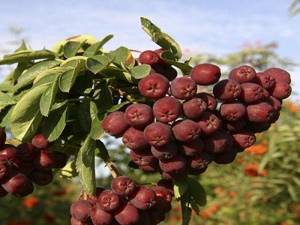
A medium-sized tree obtained by crossing varieties of rowan, apple and pear. The culture has a branching crown of a brown hue. The fruit is oblong and has a dark cherry color. A light white tint is visible at the end of each berry. The pulp is bright yellow, not dense. The taste is very pleasant and delicate, with a slight sourness and a pear aftertaste. The leaves have a medium oblong shape, pointed at the edges. The color of the plates is dark green.
Rowan Vefed
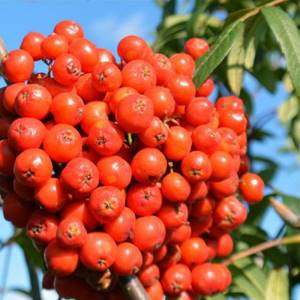
The tree is of medium height. At maturity it reaches about 4-5 m in height. The crown has a spherical shape. The shoots and trunk are brown. The fruits of the tree weigh a maximum of 2 g. They are round in shape and purple in color. Ripe berries have a pronounced sweet and sour taste. The first fruiting is observed in the 5th year of the tree’s life.
Rowan Bead
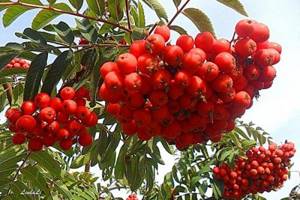
The tree does not exceed a height of 3 m. The crown has a roundish shape and is small. The branches are gray-brown in color, abundantly covered with colorful leaves. Medium sized shoots. The leaves are rounded and pointed at the edges. All plates have a rich green color. The fruits of the tree are brownish-purple. The taste is tart-sweet with a slight sour aftertaste. The tree tolerates low temperatures well and does not require special care. Due to its high characteristics, Businka rowan is often used for planting in the northern regions of the country.
Rowan Vefed has the highest degree of productivity.
Mountain ash
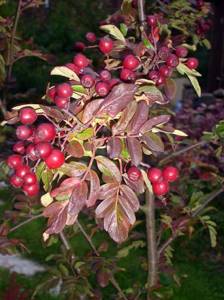
The tree can reach six meters in height. It has a medium rounded crown. Rowan fruits are dark and large. Liqueur liqueur differs from other types in its berries, which have high taste qualities. They taste sweet, slightly tart with a complete lack of acid. Tree of average productivity. It also begins to bear fruit in the fifth year of life.
Scarlet rowan
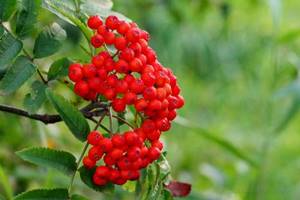
It is a rather beautiful shrub or tree that has a spherical or pyramidal crown. The rowan tree reaches ten meters in height. The tree has a well-developed root system. The leaves are dark green, not paired. The plant is distinguished by abundant and large fruits, collected in handfuls. The berries are sweet and sour, slightly tart. The pulp has a bright yellow tint. In spring, the tree is covered with inflorescences that resemble shield-shaped cones.
An excellent place for growing such rowan will be fertile, chernozem or woody clay soil. For good development, the bush should be periodically watered and fertilized. The tree loves the sun very much, so it should not be planted in the shade. The plant is resistant to high frosts and various diseases.
During flowering, scarlet rowan exudes an unpleasant aroma.
Fairytale rowan

The tree of the variety has medium height. The crown type is oval, abundantly covered with foliage. The bark has a gray tint. The shoots are elongated and straight. Ripe fruits have a red-orange hue. Each berry weighs about 2 g. The taste of rowan is sweet and sour, the pulp is quite dense. The leaves are flat, bright green with a matte tint.
The berries begin to ripen in late autumn. The presented species also perfectly withstands low temperatures and sudden changes in weather conditions. Fairy rowan is unpretentious in care, which allows it to be grown in any soil and area.
Use of rowan
The fruits of the mountain ash are a rich source of carotene, vitamins A and C. They also contain organic acids, tannins and pectins, easily digestible sugars, microelements (manganese, iron, nickel, cobalt, etc.). The vitamins in fruits are not destroyed for a long time, and this is very important for the autumn-winter period.
Dry rowan fruits are included in medicinal vitamin preparations. Rowan compote promotes bile secretion; soaked berries are a good seasoning for game dishes.
The fruits of rowan are well known in folk medicine as an antiscorbutic and diuretic. They help with hypertension and strengthen small blood vessels. The leaves contain even more ascorbic acid than the fruits. Tincture of leaves treats colds and various metabolic disorders.
Tinctures, liqueurs, compotes, marshmallows, preserves, jams, marmalades, vinegar are prepared from rowan fruits; there are recipes for making rowan kvass. The fruits of the sweet forms of rowan can be eaten fresh.
Note: In forms with bitter fruits, the bitterness disappears after freezing.
Rowan jam. Wash the berries, blanch for 4-5 minutes, place in a cooking basin, pour hot sugar syrup (1.5 kg of sugar, 600 g of water per 1 kg of fruit) and leave for 6-8 hours. After this, cook over low heat until done. During the cooking process, it is recommended to remove the bowl from the heat 4-5 times (after boiling), leave for 15-20 minutes and cook again. Pack the finished jam into heated dry jars, seal and cool.
Rowan juice. Take 2 kg of rowan fruits, 2 liters of water. Pour the washed fruits with water and cook until softened, rub through a sieve, squeeze out the juice and pasteurize in glass jars or bottles for 15 minutes. Juice can also be obtained using a juicer.
Material prepared by: horticulture specialist Buinovsky O.I.
Canadian rowan. Rowan: types and varieties, growing secrets
Everyone is accustomed to our ordinary rowan with orange fruits, but the color palette of rowan is much more diverse: there are varieties with almost black berries, there are yellow, orange, pink and even white rowan.
The genus includes about 70 (up to 100) species growing in the temperate zone of the Northern Hemisphere; 15 species and subspecies are represented in Russia, of which our usual ordinary rowan is the most popular.
The color palette of berries is varied. There is a variety called Crantz with almost black berries (a hybrid of the common chokeberry - Sorbus aucuparia L. and the black chokeberry - S. aria (L.), there are yellow and orange varieties, and the white and pink colors are given by the Koehne river (Sorbus koehneana Schneid) and r.
As usual, the Russian breeder I.V. Michurin played an important role in improving rowan trees: he used rowan, which he crossed with chokeberry, rowan, apple, pear, hawthorn and even medlar.
Rowan (Sorbus aucuparia)
Distributed in the European part of Russia, Siberia and the Urals. Its age is comparable to that of a human - 80 and even 100 years, and it produces the greatest harvests in middle age - at 35–40. As a northern crop, rowan tolerates temperatures as low as -50 °C and therefore grows even in areas close to the Far North.
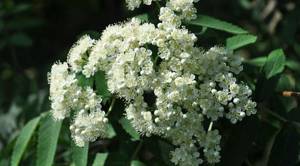
Flowering rowan
Particularly popular in cultivation is the weeping cultivar Pendula, with branches reaching down to the ground, which is propagated by grafting. Depending on the grafting height, plants can be grown both on a high (more than 150 cm) and low (up to 50 cm from the ground) trunk.
Mixed rowan (Sorbus commixta)
Rowan mixed Dodong
One of the most spectacular varieties. A compact tree with a columnar crown and a very exotic appearance. Young seedlings have a narrow crown; with age it becomes spreading and reaches 5 m in diameter. In a sunny location, the leaves turn a flaming orange-red color in the fall. The variety is relatively new, obtained at the end of the 20th century from seeds found by a Swedish botanist on the Japanese island of Ulung.
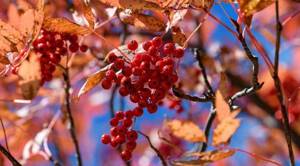
Rowan mixed
Rowan aria, mealy, round-leaved (Sorbus aria)
Tree, sometimes shrub up to 6–12 m high, with decorative foliage, dark green above, white tomentose below. Young leaves are pubescent on both sides, autumn color is sometimes bronze-yellow. The fruits are orange-red.
In severe winters it can freeze.

Rowan aria
Rowan aria Lutescens
Slow-growing tree, 6–12 m high, with a dense crown. Leaves when blooming are light, pubescent, mature gray-green
Rowan aria Magnifica
A slow-growing tree, up to 6–12 m high, with a wide-conical crown. The fruits are slightly larger than the species, orange-red or deep red, with dark and light dots.
Thuringian rowan (Sorbus × thuringiaca)
Shrub or tree up to 10 m high, with an ovoid crown. The leaves are green, whitish-gray below, pubescent. The flowers are white, the fruits are orange-red.
Rowan Thuringia Fastigiata
A slow-growing shrub or tree, up to 5–7 m high. The variety is suitable for shaping.
Elderberry (Sorbus sambucifolia)
Shrub up to 2.5 m high, with a rounded crown. The leaves are dark green, lighter below, yellow-brown in autumn. The flowers are reddish or white, the fruits are decorative: bright red, do not fall off all winter.
Rowan elderberry
Cashmere rowan (Sorbus cashmiriana)
A short-lived tree or shrub, up to 4–6 m high, with an openwork crown.
The leaves are dark green, light green below, yellow in autumn. The flowers are white-pink, the fruits are white, sometimes pinkish-white, and remain on the branches for a long time after the leaves have fallen. In severe winters, annual growths may freeze.

Ashmere rowan
Rowan Koehne (Sorbus frutescens, S. koehneana)
The species received its name in honor of the German botanist Emil Köhne (1848–1918).
Shrub or tree 3–4 m high. Leaves are green, orange and red in autumn. Flowers and fruits are white. In severe winters, shoots may freeze.
Description of mountain ash
Rowan (Sorbus) is a genus of deciduous frost-resistant shrubs and trees from the Rosaceae family. Rowan trees grow in forests and mountainous areas; their distribution range extends from the far north to the middle zone of the northern hemisphere. The genus Rowan includes about 200 species. This article is about the Common Rowan (Sorbus aucuparia) - charming trees or shrubs that are familiar to us from childhood. The leaves of such rowan trees are complexly elongated, each leaf consists of many pointed narrow leaflets.
Since pagan times, rowan has been part of the life and culture of Celtic, Scandinavian and Slavic tribes. In their beliefs, rowan was endowed with magical powers, capable of protecting soldiers during war, protecting them from the world of the dead, and also protecting them from witchcraft. To protect against the evil eye, crosses were made from rowan twigs, which were tied with red thread and sewn to clothes. Rowan leaves were used to line the shoes of the bride and groom during the wedding.
Staves were made from rowan wood. Rowan branches were used to decorate the Maypole at Beltane. Rowan trees were planted near the home, and in some places it is still considered a bad omen to uproot or damage a rowan tree in your yard. If you look closely at the underside of the rowan berry, you will notice that its shape is an equilateral five-pointed star, and this is one of the most important ancient pagan symbols - a symbol of protection.
Rowan wood is hard and elastic, and lends itself well to processing. Since ancient times, spindles and runes have been made from rowan. And rowan berries are used to produce red organic dye for fabric. Rowan fruits are unusually rich in vitamin C and have long been used in home cooking to make wine, beer, jams, preserves, jellies, jelly, desserts and sauces. Birds also love rowan, for which it is an important source of food in winter. They taste sweet and sour or bitter and sour; the latter are recommended to be consumed ready-made with added sugar.
Rowan pomegranate. Description of the variety of mountain ash Garnetnaya
Rowan Pomegranate is the result of the breeding work of Michurin I.V., who crossed the Siberian hawthorn and the common rowan. The resulting hybrid was named Crataegosorbus Michurin (hawthorn). Later, thanks to its dark garnet-colored berries, the variety was named Rowan Pomegranate (photo).
Pomegranate rowan is a tall tree with a spreading crown, which has some similarities with the common rowan. The hybrid is characterized by a short duration of industrial cultivation, frost resistance and high adaptive qualities. The tree's shoots are resistant to high and low temperatures and also ripen well.
The variety belongs to light-loving crops, but it can fully develop and bear fruit when growing in shaded areas. Pomegranate rowan stands out from a number of other varietal red fruits due to the size of the berries and their original color. The decorative beauty of the tree is preserved all year round, including in winter.
Description of the varietal characteristics of pomegranate rowan:
- average fruiting period is 20-25 years;
- height of an adult tree – up to 3-4 m;
- the crown is thick, wide, decorative;
- spreading branches;
- foliage is imparipinnate, consisting of several shield-shaped leaves;
- mixed type of fruit buds;
- type of root system – fibrous;
- the flowers are small, white, collected in semi-oval inflorescences;
- the shape of the fruit is spherical, with small edges;
- the color of the berries is burgundy-garnet, with a slight bluish tint;
- average fruit weight 1-1.6 g;
- yield 20-25 kg per season;
- the taste of the berries is sweet and sour, with a light, pleasant note of tartness;
- The pulp of the fruit is dense and yellow.
Dwarf rowan. Description
Picturesque rowan trees can be grown in any garden. They are absolutely winter-hardy, unpretentious, and vary in size from dwarf bushes to majestic trees. Rowan will decorate any garden with equal success - classic, in the Russian style, and fruit garden. It can be planted as a tapeworm in an open place so that it is visible from all sides, in groups or in company with birch, spruce, and rose hips. Rowan is a good neighbor; many shrubs and ornamental perennials grow well under its translucent crown. For the northern regions, it is primarily valuable for its high winter hardiness.
It is good from spring to autumn. The boil of white flowers is replaced by carved green leaves and, finally, scarlet clusters - a decoration for any landscape. And how many new varieties with tasty and healthy fruits!
Its fruits are an excellent preventive and therapeutic agent for vitamin deficiencies, diseases of the liver, kidneys, and stomach, and aromatic rowan liqueurs and tinctures are probably familiar to everyone.
Rowan is the heroine of many legends and traditions. People knew that wild animals were treated with it: bears, moose, deer. Birds adore rowan berries, and bees willingly visit its fragrant flowers.
On September 23, Rus' celebrated the day of Peter the Fieldfare - they tied rowan branches with red berries into bunches and hung them under the roof of the house to protect its inhabitants from diseases and misfortunes. Rowan branches were placed in bins with supplies so that everything would be preserved. Much later it was found that rowan is rich in phytoncides. After the first frost, the bitterness of the rowan berries weakened and they were used as food. The strong reddish wood was suitable for carpentry, and the bark was suitable for tanning leather.
In folk songs, rowan was associated with unrequited love, separation, loneliness, and sadness. She can’t get to the oak tree, and that’s why the beauty is in deep sadness.
It is believed that rowan, along with oak, pine, acacia and maple, has positive bioenergy, which it can transmit to people. It’s hard to say whether this is true or not, but if you admire the slender mountain ash strewn with red clusters, your soul becomes lighter.
Rowan care
Growing rowan in the garden
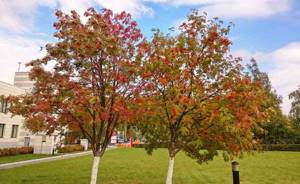
Growing rowan involves performing certain procedures familiar to a gardener: watering, weeding, loosening the soil, fertilizing, pruning, and measures to protect against diseases and pests.
Rowan is watered during the period of lack of precipitation, and this is certainly done at the beginning of the growing season and after planting in the ground, as well as two to three weeks before harvesting and two to three weeks after it. It is better to pour water into the grooves made around the perimeter of the tree trunk circle. Water calculation is from 2 to 3 buckets per plant, however, when determining the required amount of water, it is necessary to take into account the age of the plant, the composition and condition of the soil.
Loosening the soil in the tree trunk circle is carried out in early spring, then 2-3 times during the summer and certainly immediately after harvesting. It is more convenient to loosen the surface on the second day after watering or rain, while at the same time removing weeds. After loosening, the tree trunk circle is re-mulched with organic matter.
They increase the yield of rowan by introducing systemic fertilizing. From the third year of life in the spring, 5 to 8 kg of compost or humus and 50 g of ammonium nitrate are added under the trees. In the first days of June, 10 liters of mullein solution (in a ratio of 1:5) or bird droppings (in a ratio of 1:10) are poured under each rowan tree. Organics can be replaced by Agrolife solution. At the end of summer, half a liter of wood ash and 100 g of superphosphate should be added under the trees.
Rowan must be pruned in early spring, before the sap begins to flow and the buds begin to awaken: shoots that extend at right angles, diseased, shriveled shoots and those growing deeper into the crown are removed. In rowan varieties that bear fruit on last year's shoots, it is necessary to thin out and shorten the branches slightly, and in those that bear fruit on various types of fruit formations, the ringlets are systematically thinned out and rejuvenated and the skeletal branches are shortened.
In general, pruning is done to ensure uniform illumination of the crown, which accordingly contributes to a higher yield. Nevertheless, the crown of the rowan tree is pyramidal, therefore, the branches grow at an acute angle to the trunk, and this deprives them of strength. When forming skeletal branches, your task is to try to bring them out at a right or obtuse angle.
Trees with poor growth require rejuvenating pruning, which is done on two- or three-year-old wood to encourage the growth of new shoots.
Pests and diseases of rowan
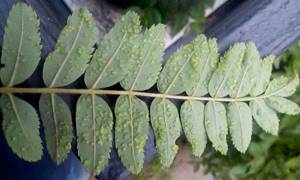
The first signs of damage to a tree by pests or pathogenic infections may appear as early as May-June. What diseases does this culture suffer from? Rowan is affected by anthracnose, powdery mildew, monoliosis, scab, septoria, rust, brown and gray spots, necrosis (black, nectria and cytospore) and viral ring mosaic. If you purchased a healthy seedling, and the rowan planting and care were carried out in accordance with the agricultural practices of the crop, then the tree is unlikely to have any health problems: diseases only affect weakened plants. However, you need to be prepared for any troubles.
Let us say right away that diseases such as mosaic and all types of necrosis cannot be cured, therefore the most important way to protect rowan from being affected by these incurable diseases is preventive measures. They consist of careful selection of seedlings, pre-sowing soil treatment to prevent infections, destruction of insects that carry viruses, and keeping tree trunk circles clean. It is very important to carefully examine the trees in the garden as often as possible, because it is much easier to defeat a disease at the very beginning of its development than to save an already dying plant.
In articles on planting and growing fruit trees of the Rosaceae family, we have repeatedly described the signs of the most common diseases and ways to combat them.
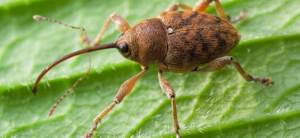
Weevil
As for pests, mountain ash under unfavorable conditions is affected by up to 60 insects and mites, damaging both leaves and shoots, flowers, fruits, buds and seeds of the plant. Most of these pests parasitize all fruit crops of the Rosaceae family. Most often found on mountain ash:
- Weevils, which are destroyed with the drug Karbofos;
- Bark beetles: against them, rowan is treated with Aktara, Confidor and Lepidotsid;
- Rowan gall mites are destroyed by colloidal sulfur;
- Green apple aphids are killed by the drugs Actellik and Decis;
- Scale insects are destroyed with the drug 30 Plus;
- Moths: Chlorophos, Karbofos or Cyanox are used to control these pests;
- Rowan moths do not tolerate treatment with Chlorophos;
- Apple fruit sawflies die after treating rowan with white mustard infusion (10 g of mustard powder is poured into 1 liter of water, left for a day, then diluted with water in a ratio of 1:5).
Treating the rowan leaves with a solution of 100 g of copper sulfate in 10 liters of water before sap flow begins can protect against pest damage. Spring treatments of trees and the soil under them with Nitrafen have also proven themselves to be excellent. For preventive purposes, every autumn fallen leaves and plant debris are removed from under the trees and the soil in the tree trunks is dug up.



